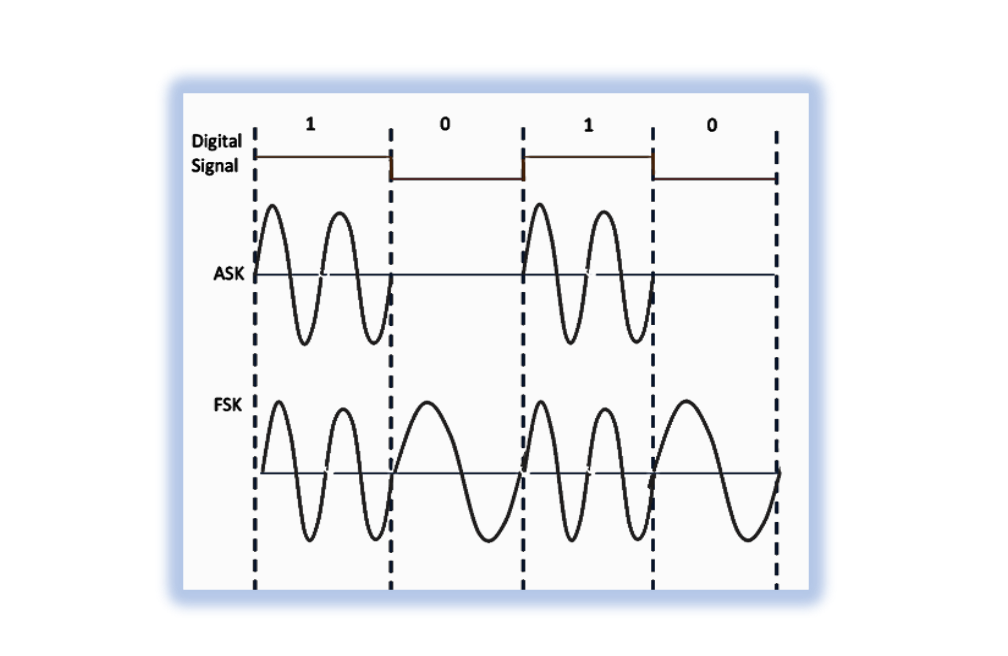
Analog and Digital Modulation Techniques
Analog Modulation
Analog modulation, the precursor to digital modulation, revolutionized communication by enabling the transmission of voice, video, and other analog signals over vast distances. It involves modifying continuous signals, such as sound or video, to carry information across a communication medium.
Types of Analog Modulation:
1. Amplitude Modulation (AM): AM alters the amplitude of a carrier signal in proportion to the waveform of the analog signal being transmitted. Variants like Double Sideband (DSB-AM) and Single Sideband (SSB-AM) are used to optimize bandwidth and power efficiency.
Read about Analog Transmitters with examples. It includes Transmitter for AM and FM modulation
2. Frequency Modulation (FM): FM modifies the frequency of a carrier signal according to the changes in the analog signal’s amplitude. It’s widely used in radio broadcasting due to its resistance to amplitude variations and noise.
3. Phase Modulation (PM): PM changes the phase of the carrier signal in response to the analog signal’s variations. It’s closely related to FM and is utilized in various communication systems, especially in scenarios requiring precise phase information.
Applications of Analog Modulation:
- Radio Broadcasting: AM and FM modulation techniques have historically been the backbone of radio transmission, allowing for the broadcast of music, news, and other content.
- Television Broadcasting: Analog modulation facilitated the transmission of analog TV signals over the airwaves, enabling the widespread distribution of visual content.
- Telephone Networks: Analog modulation played a significant role in early telephone systems, allowing voice signals to be transmitted over long distances.
Advantages and Challenges:
Advantages:
- Compatibility: Analog modulation techniques were foundational in establishing early communication systems, providing a means to transmit voice and video signals.
- Simple Implementation: Analog modulation, especially AM, was relatively simpler to implement in the early stages of communication technology.
Challenges:
- Susceptibility to Noise: Analog signals are more prone to interference and noise degradation compared to digital signals, impacting signal quality.
- Bandwidth Efficiency: Analog modulation techniques often utilize more bandwidth compared to their digital counterparts, limiting the number of channels that can be transmitted simultaneously.
Transition to Digital Modulation:
While analog modulation played a pivotal role in establishing communication networks, the transition to digital modulation gained momentum due to the advantages it offered in terms of signal quality, efficiency, and robustness against noise. Digital modulation paved the way for higher data rates, enhanced error correction capabilities, and a broader range of applications, ultimately overshadowing analog modulation in many aspects of modern communication systems. Although digital modulation dominates contemporary communication technologies, analog modulation’s legacy persists in certain domains and continues to be relevant in specific applications where compatibility with older systems or specific signal characteristics are required.
Digital Modulation
Digital modulation lies at the heart of modern communication systems, shaping the way data is transmitted across various channels. In the realm of telecommunications, where information is exchanged at lightning speeds, digital modulation serves as the cornerstone of efficiency, reliability, and signal integrity.
Understanding Digital Modulation
At its core, digital modulation is the process of altering a carrier signal’s characteristics to encode digital information for transmission. It involves converting digital data into a format suitable for transmission through a chosen medium, typically over the airwaves or through wired connections. By manipulating specific parameters of the carrier signal, such as amplitude, frequency, or phase, digital information is embedded within the signal.
Types of Digital Modulation
1. Amplitude Shift Keying (ASK): ASK modulates the amplitude of the carrier signal to represent binary data. The variations in amplitude signify different digital states (0s and 1s), making it relatively simple and cost-effective for transmission.
2. Frequency Shift Keying (FSK): FSK alters the frequency of the carrier signal to convey digital information. It uses different frequencies to represent binary values, with each frequency denoting a specific digital state.

3. Phase Shift Keying (PSK): PSK changes the phase of the carrier signal to encode digital data. By adjusting the phase of the signal, different phases represent distinct digital symbols or bits.
4. Quadrature Amplitude Modulation (QAM): QAM is a more complex form of modulation that combines both amplitude and phase variations to transmit multiple bits simultaneously. It achieves higher data rates by encoding information in both amplitude and phase changes.
Advantages of Digital Modulation
- Robustness: Digital signals are less susceptible to noise and interference compared to analog signals, ensuring more reliable data transmission.
- Efficiency: Digital modulation allows for the transmission of vast amounts of data in a compact form, enabling high-speed communication and efficient use of bandwidth.
- Error Correction: Techniques like error correction coding can be integrated into digital modulation schemes, enhancing the system’s ability to detect and correct transmission errors.
- Compatibility: Digital modulation facilitates compatibility with various digital devices, enabling seamless integration into modern communication systems.
Applications of Digital Modulation
The widespread use of digital modulation extends across numerous fields:
- Wireless Communication: Mobile networks, Wi-Fi, Bluetooth, and satellite communication systems heavily rely on digital modulation for data transmission.
- Broadcasting: Digital TV and radio broadcasting leverage modulation techniques for efficient signal delivery and reception.
- Internet Connectivity: Digital modulation enables high-speed internet connections through DSL, cable modems, and fiber-optic networks.
- Remote Sensing and Radar Systems: Radars and remote sensing devices utilize digital modulation for precise data transmission and reception.
Future Trends
As technology continues to advance, the evolution of digital modulation remains dynamic. Emerging technologies like 5G networks, Internet of Things (IoT), and beyond aim to harness more sophisticated modulation schemes for faster, more reliable, and efficient communication. Digital modulation stands as a testament to the relentless pursuit of innovation in the realm of telecommunications. Its adaptability and efficiency continue to drive the evolution of communication systems, paving the way for a more interconnected and data-driven world.

Learn more about more topic like this. Browse various RF course on our website and watch the course videos for more detailed understanding https://rahsoft.com/courses/. Rahsoft also provides a certificate on Radio Frequency. All the courses offer step by step approach.



